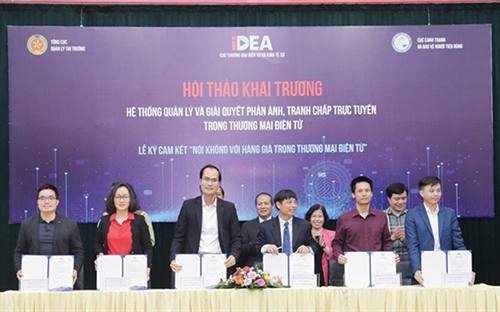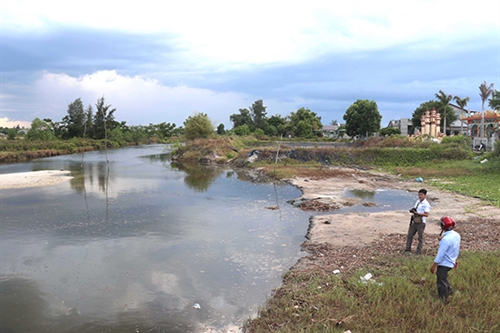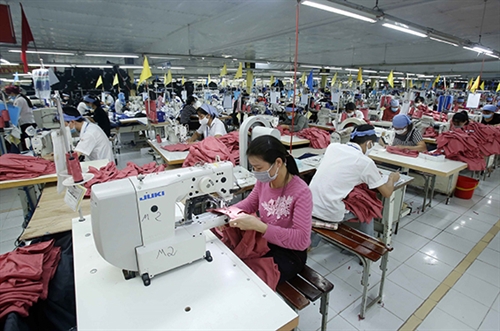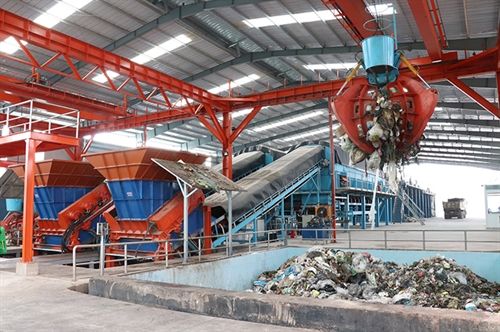Le Ngoc Van Nhi
In the context of the extensive and pervasive integration of the Industrial Revolution 4.0 and the impact of the COVID-19 epidemic, e-commerce business models have successively surpassed traditional ones. According to the e-Conomy SEA 2020 by Google, Temasek, and Bain & Company, Vietnam’s e-commerce industry grew by 46 percent. Against that backdrop, the Prime Minister on May 15, 2020, adopted Decision 645/QD-TTg approving the national e-commerce development master plan for the 2021-25 period. In order to achieve the goal set in the master plan, i.e., building a fair, competitive, and sustainable e-commerce market, it is necessary to improve legal documents on resolutions to disputes and claims, and mechanisms for ensuring the protection of consumers’ rights to e-commerce transactions. The purpose of this paper is to provide methods of resolutions to disputes and claims which are applicable to transactions on e-commerce platforms in Vietnam.
Methods of resolutions to disputes and claims over transactions on e-commerce platforms
The terms related to resolutions to disputes and claims are often stipulated in Terms of Service, Terms of Use, and/or Regulation on operation for the e-commerce trading floors. E-commerce trading floors provide the procedure for resolutions to disputes and claims into a separate section of the user interface to look it up conveniently.
Let’s take Lazada, a top e-commerce platform in the country, for example.
The procedure for resolutions to disputes and claims uploaded by Lazada on its website on November 19, 2020, includes the following three steps[1]:
- Step 1: The Buyer initiates the claim in respect of products via the customer care hotline 19001007 or www.lazada.vn/contact.
- Step 2: Customer Care Department receives the Buyer’s claim, and depending on the nature and seriousness of the claim, takes appropriate measures to assist the Buyer in settling the dispute.
- Step 3: In case that the case falls beyond Lazada’s capabilities and powers, the Buyer may bring the case to competent authorities for settlement.
From these above two provisions, it can be seen that consumers’ claims are initially heard and resolved by Lazada. In the event a dispute falls beyond Lazada’s capabilities and powers, the buyer may bring the dispute to the Vietnam International Arbitration Center (VIAC) at the Vietnam Chamber of Commerce and Industry. In this case, the arbitral award will be final and binding on the parties from the date of its issuance, unless it is cancelled or denied the enforcement.
As for Shopee, the principal rival of Lazada in Vietnam, the Singapore-based platform encourages the resolution of disputes between parties through negotiation and conciliation. In the event the parties cannot negotiate and request Shopee to resolve the case, Shopee’s procedure for resolutions to disputes and claims includes four steps as follows[3]:
- Step 1: To make a claim for Return/Refund to Shopee, the Buyer needs to click on the claim taking place on the page “Buy Goods”, section “Purchase Order”. The system shall take note of the Buyer’s claim. Once a claim for Return/Refund is made, Shopee will withhold the amount of money made payable to the Seller until the dispute is completely settled. Disputes not related Return/Refund claim can be sent to Shopee via https://help.shopee.vn/vn/s/contactusform or Call Center 19001221.
- Step 2: Shopee’s Customer Care Department receives requests from claimants/disputing parties and takes specific measures to assist the claimants/disputing parties to resolve their dispute depending on the nature and severity of the case.
- Step 3: Claims for Return/Refund are settled in accordance with Shopee’s Return and Refund Policy. For a dispute without Return/Refund claims, Shopee will require dispute-related parties to provide relevant information/documents and, within seven working days after receiving sufficient information and documents, provide a resolution.
- Step 4: For cases which fall beyond its capabilities and powers, Shopee will request disputing parties to bring the case to a competent state agency in accordance with the law. Shopee respects and strictly abides by the provisions of the law on the protection of consumers’ rights. […].
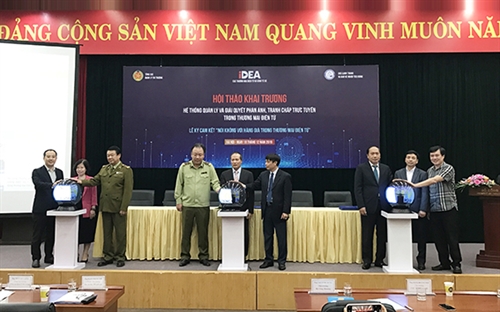 |
| Launching ceremony of the online dispute resolution system __Photo: Duc Duy/Vietnam+ |
According to Article 16.1.b and Article 38 of the 2010 Law on Protection of Consumers’ Interests, general trading conditions will be invalid if they restrict or exclude consumers’ rights to make claims and initiate lawsuits, and in case traders and service providers include the arbitration term in standard-form contracts or general trading conditions, individual consumers will be entitled to choose another method to resolve arising disputes.
In addition, pursuant to Article 17 of the 2010 Law on Commercial Arbitration[5] and Article 4.5 of Resolution 01/2014/NQ-HDTP of the Judicial Council of the Supreme People’s Court guiding the implementation of a number of provisions of the Law on Commercial Arbitration, in case the general conditions on provision of goods/service prepared by a goods/service supplier contains an arbitration term, customers may still choose another method besides arbitration to resolve their disputes. According to the 2010 Law on Protection of Consumers’ Interests, there are four methods to resolve disputes between consumers and goods traders/service providers, including negotiation, commercial mediation (differentiating from self-mediation between parties involved in e-commerce transactions), arbitration, and litigation. These provisions optimize consumers’ rights to choose the dispute resolution method despite the fact that regulations at e-commerce trading floors restrict. They also prevent goods traders and service providers from taking advantage of their ascendancy to unilaterally impose dispute resolution methods without the consent or against the will of customers[6].
In fact, disputes arising from transactions on e-commerce trading floors are often of negligible value. Meanwhile, litigation costs are relatively higher than goods or service prices and it might takes a long time to resolve a dispute by cumbersome legal procedures. These make consumers hesitate about initiating a lawsuit. Therefore, methods of traditional and direct dispute resolutions seem no longer appropriate. To adapt and promote e-commerce development, foreign countries have researched and proposed online dispute resolution (ODR). Online dispute resolution is understood as the use of alternative dispute resolution (ADR) methods on online platforms with the assistance of information technology. Not standing apart from the commonly growing trend in the world, the Vietnam’s legal system has been gradually supplemented and improved with the introduction of the 2005 Law on E-transactions, the 2006 Law on Information Technology, and relevant sub-law documents. Nevertheless, up till now, there remains a lack of specific provisions on the order, procedures and scope of ODR. This is a reason why the Government has proposed solutions to develop markets and enhance consumers’ credibility to e-commerce including the building of an effective mechanism for dispute resolution with the application of digital technology; participation in regional and international online dispute resolution mechanisms; and research and application of online dispute resolution systems to enhance the protection of consumers’ rights to e-commerce, promote the development of cross-border e-commerce, especially for small- and medium-sized enterprises[7].
In addition to the above methods of dispute resolutions, consumers can use the System of management and resolution to online claim and dispute over e-commerce. The System includes three main modules that are the System for managing and monitoring e-commerce activities via Online.gov.vn - level 4 public service upgraded to replace the portal online.gov.vn launched in 2013; the System of information, warning, online inquiry, and resolution to online claim and dispute over e-commerce via chonghanggia.online.gov.vn; and the System of online report on e-commerce activities of businesses via baocao.online.gov.vn[8].
There are some jobs that need to be shortly done in order to boost the development of a fair e-commerce market and better protect consumers’ interests, especially upon occurrence of dispute over e-commerce transactions.
Firstly, information technology infrastructure facilities should be upgraded and improved so as to help consumers acquire information and make claims in a convenient manner and competent state agencies monitor, inspect and handle violations quickly and easily, thus saving time for information processing.
Secondly, it is necessary to further review and revise existing legal documents on e-commerce transactions and promulgate new ones in order to form a complete legal framework for resolving e-commerce disputes.
Thirdly, further training courses on e-commerce and information technology should be organized for state officials engaged in resolution of e-commerce disputes to improve their professional knowledge and skills.-
“1. Traders, organizations, or individuals that own e-commerce trading websites shall receive and settle customers’ claims to contracts concluded on their e-commerce websites.
2. Disputes between traders, organizations, or individuals that sell goods and provide services and their customers during the performance of contracts must be settled on the basis of the contractual terms published on the websites at the time of conclusion of these contracts and in accordance with relevant laws.
3. Traders, organizations, or individuals that sell goods and provide services shall not take their ascendancy on the e-environment to unilaterally settle disputes without the consent of customers.
4. The dispute resolution must be settled through negotiation between the parties, mediation, arbitration, or court according to prevailing procedures and regulations on dispute resolution.
5. Resolutions to claims and disputes on e-commerce service provision websites:
a/ Traders and organizations providing e-commerce services shall clearly publish on their websites the process of receiving and responsibility for settling customers’ claims and the dispute resolution mechanism related to contracts concluded on their e-commerce websites;
b/ If traders and organizations providing e-commerce services fail to publish information pursuant to Point a of this Clause, they shall directly receive and settle customers’ claims and disputes related to contracts concluded on their e-commerce websites; and
c/ Traders and organizations providing e-commerce services may participate in the mediation of disputes arising between customers and sellers on their e-commerce websites.”




